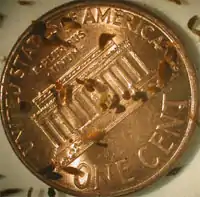Convoluta convoluta
Convoluta convoluta, also known as the acoellous turbellarian flatworm,[2] is a small acoel in the family Convolutidae. Native to the Baltic Sea, it invaded the Gulf of Maine in the late 1990s.[3]
| Convoluta convoluta | |
|---|---|
 | |
| C. convoluta with a coin 19 mm in diameter | |
| Scientific classification | |
| Domain: | Eukaryota |
| Kingdom: | Animalia |
| Phylum: | Xenacoelomorpha |
| Order: | Acoela |
| Family: | Convolutidae |
| Genus: | Convoluta |
| Species: | C. convoluta |
| Binomial name | |
| Convoluta convoluta Peter Christian Abildgaard, 1806. In: O.F. Müller, Zoologia Danica, 4. | |
| Synonyms[1] | |
|
List
| |
Diet and symbiosis
This flatworm consumes juvenile settling mussels and harpacticoid copepods.[4] It also engages in a symbiosis with a diatom of the genus Lichmophora,[5] which has also invaded the Gulf of Maine.
Impact and ecology in the Gulf of Maine
In the Gulf of Maine, the impact of this species appears minimal as the habitat is presumably saturated with food, and the species is ultimately self-limited by species competition.[6] It also appears limited to wave-protected habitats, where it prefers filamentous algae.[6] In 2001, it occurred in densities of up to 19 per square centimeter.[3]
References
- "Convoluta". Archived from the original on 2015-06-10. Retrieved 2013-10-07.
- Convoluta convoluta (Abildgaard, 1806). gbif.org. Accessed 2023-06-06.
- Rivest, Brian R.; Coyer, James; Tyler, Seth (1999). "The first known invasion of a free-living marine flatworm". Biological Invasions. 1 (4): 393–394. doi:10.1023/A:1010076418671. ISSN 1387-3547. S2CID 27245804.
- Mamkaev, Y.V., Seravin, L.N., 1963. Feeding habits of the acoelous turbellarian Convoluta convoluta (Abildgaard). Zoologicheskii Zurnal 42, 197–205
- Apelt, G., 1969. Die Symbiose zwischen dem acoelen Turbellar Convoluta convoluta und Diatomeen der Gattung Lichmophora (In German). Marine Biology (Berlin) 3, 165–187
- Byrnes, J.E. and Witman, J.D. 2003. Impact assessment of an invasive flatworm, Convoluta convoluta, in the Southern Gulf of Maine. Journal of Experimental Marine Biology and Ecology 203: 173–191
This article is issued from Wikipedia. The text is licensed under Creative Commons - Attribution - Sharealike. Additional terms may apply for the media files.